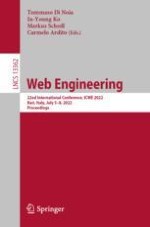This book constitutes the thoroughly refereed proceedings of the 22nd International Conference on Web Engineering, ICWE 2022, held in Bari, Italy, in July 2022.
The 23 revised full papers and 5 short papers presented were carefully reviewed and selected from 81 submissions. The books also contains 6 demonstration and poster papers, 7 symposium and 5 tutorial papers. They are organized in topical sections named: recommender systems based on web technology; social web applications; web applications modelling and engineering; web big data and web data analytics; web mining and knowledge extraction; web security and privacy; web user interfaces.
